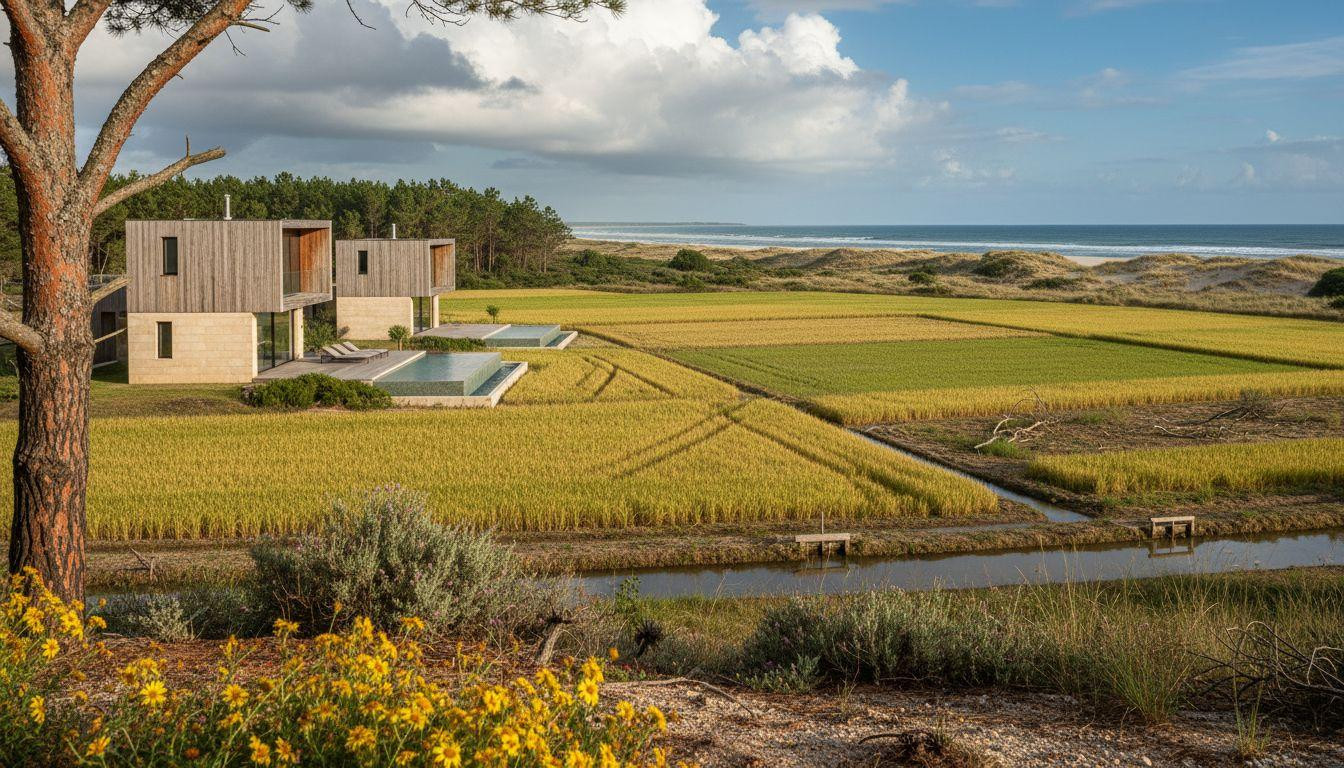The Algarve receives 5.2 million visitors annually, packing its 155-mile coastline with resort towers and tourist infrastructure. Faro Airport processes 9.8 million passengers yearly, feeding a machine that generates $340 million monthly but leaves little room for quiet contemplation. One hour south of Lisbon, Comporta offers the same Atlantic luxury with rice fields instead of crowds, design restraint instead of excess.
Why the Algarve lost its soul to numbers
September 2025 data tells the story: 597,700 guests, 2.38 million overnight stays, and average daily rates of $167. The Algarve commands 27.9% of Portugal’s total tourism revenue, a dominance that reshapes entire coastal communities. British visitors alone account for 4.4 million annual arrivals.
Local fishing villages now serve tourists exclusively. Traditional restaurants close as rent prices soar beyond local wages. The success metrics are impressive: occupancy rates hit 72.8% even in shoulder season. But walking through Albufeira or Lagos reveals the cost: authentic Portuguese coastal life displaced by international resort culture.
Portugal’s volcanic village maintains heritage authenticity that the Algarve’s development model abandoned decades ago.
Comporta preserves what mass tourism destroys
Where rice paddies meet raw luxury
Comporta’s 300 permanent residents work 2,000 hectares of functioning rice fields visible from luxury villa terraces. Sublime Comporta operates across 17 hectares, integrating farm-to-table dining with organic gardens. Quinta da Comporta features a 130-foot infinity pool overlooking agricultural landscapes that feed the restaurant.
The architectural philosophy requires horizontal design that dissolves into pine forests. New construction uses raw wood, natural stone, and linen interiors. No building exceeds two stories. The 2,100-foot private runway limits mass tourism access by design.
The economics of intentional scarcity
Current capacity totals approximately 500 luxury rooms across all properties. Annual visitors number 30,000-50,000 maximum, compared to the Algarve’s millions. Peak season (June-August) averages $910 nightly, while low season (September-November) drops to $365.
This 60% seasonal differential reflects deliberate inventory limitations. Most properties operate 20-70 rooms maximum. Medieval fortress villages nearby maintain similar population-to-visitor ratios.
What you actually experience in Comporta
12 miles of empty Atlantic coastline
Morning walks reveal pristine beaches accessible through pine forest paths. Atlantic fog creates diffused light quality resembling Scandinavian clarity. Water temperatures reach 72°F in July, identical to Algarve conditions. The difference: no umbrellas, no beach bars, no crowds.
Acoustic landscapes center on wave rhythm and wind through trees. Human conversation carries across distances. The absence of construction noise, traffic, or music creates heightened sensory awareness of natural textures and smells.
Time moves at agricultural pace
Restaurant meals extend 3+ hours as standard practice, not special occasion. Rice harvest season (September-October) involves community participation visible from accommodation terraces. Cork bark harvesting follows traditional 9-year cycles that guests observe firsthand.
Digital disconnection occurs through limited cellular coverage rather than resort policies. Welsh coastal alternatives employ similar technology restraint to preserve atmosphere.
The window closes with Six Senses and JNcQUOI
Two major developments opening in 2028 will add 192 luxury accommodations, representing 40% capacity increase. Six Senses Comporta brings international hotel standards with 70 keys and 58 branded residences. JNcQUOI Club spans 405 acres with championship golf and full resort amenities.
Current moment (November 2025) offers final opportunity to experience Comporta before transformation. Low season provides genuine solitude, authentic agricultural community interaction, and most favorable pricing. The design philosophy emphasizes horizontal architecture dissolving into forest, but scale inevitably changes character.
Greek island alternatives face similar development pressures as luxury tourism discovers previously overlooked coastal destinations.
Your questions about Comporta answered
How do accommodation costs compare to the Algarve?
Comporta’s entry-level luxury starts at $180 nightly (Independente Comporta), while mid-range properties range $230-350. High-end resorts command $350-970 depending on season and villa configuration. The Algarve’s equivalent properties average $200-400, but Comporta’s scarcity creates premium positioning above mass-market alternatives.
What makes the design philosophy unique?
Belgian architect Vincent Van Duysen’s influence creates “sensorial, immersive, organic” spaces using local materials exclusively. Strict guidelines require architecture to celebrate natural pine forests and sand dunes rather than dominate them. The result emphasizes material authenticity over decorative luxury common in Mediterranean resorts.
How does visitor density compare practically?
The Algarve’s 155-mile coastline accommodates 5.2 million annual visitors, creating density of 33,500 visitors per coastal mile. Comporta’s 7-mile beach serves maximum 50,000 annual visitors, equaling 7,100 per mile. This 5x difference in density creates fundamentally different experiences of space, sound, and solitude.
Late afternoon light strikes the Atlantic identically from both coastlines. In the Algarve, it illuminates resort balconies and crowded beaches. In Comporta, it catches rice field geometry and empty sand stretches, illuminating Portugal’s coast as it existed before tourism transformed it forever.
